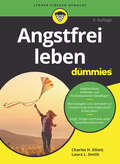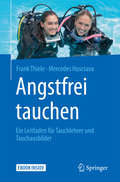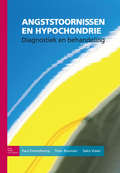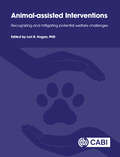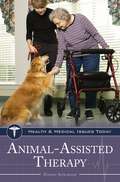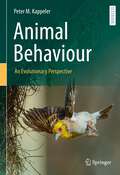- Table View
- List View
Angstfrei leben für Dummies (Für Dummies)
by Charles H. Elliott Laura L. SmithViele Menschen leiden unter à ngsten - sei es Platzangst, Flugangst, Angst vor Zurückweisung, Angst vor dem Verlust des Partners oder Kindes oder Angst vor dem Verlust des Arbeitsplatzes. So unterschiedlich diese à ngste sind, eines haben sie gemeinsam: Sie beeinträchtigen das Leben der Betroffenen und ihrer Angehörigen enorm. »Angstfrei leben für Dummies« hilft mit Selbsttests und einfachen à bungen, einen Weg aus dem Teufelskreis von Angst und Sorgen zu finden. Dieser Ratgeber zeigt, wie Sie Ihren à ngsten Schritt für Schritt begegnen können und wie Sie sie schlieà lich überwinden und sich nicht mehr von ihnen beherrschen lassen.
Angstfrei tauchen: Ein Leitfaden für Tauchlehrer und Tauchausbilder
by Frank Thiele Mercedes HuscsavaPanik unter Wasser? Ein Alptraum für Tauchschüler und Tauchlehrer. Damit dies nicht geschieht, liefert das vorliegende Buch Tauchlehrern und Tauchausbildern wertvolle Informationen, wie man Stress oder Ängsten bei Tauchschülern erfolgreich begegnet. Die Autoren erläutern das menschliche Verhalten dabei sowohl aus wissenschaftlicher Sicht, also „Warum haben wir Angst?“, oder „Wie entsteht Angst überhaupt?“ und geben gleichzeitig zahlreiche Tipps, die in einer Akutsituation helfen - vor oder während des Tauchgangs. Auch auf die Besonderheiten beim Tauchen mit Kindern in den verschiedenen Altersgruppen geht das Werk ein.
Angstkrankheiten und ihre Therapie
by Josef SchöpfDie in Psychiatrie und Psychotherapie erzielten Fortschritte sind im Bereich der Angstkrankheiten besonders deutlich sichtbar. Das Buch gibt einen Überblick über die moderne Krankheitslehre zu dieser Störungsgruppe. Die Aufklärung des Patienten und seiner Angehörigen über die Erkrankung wird ebenso erörtert wie die Prinzipien der kognitiven Verhaltenstherapie und die Pharmakotherapie. Hinweise auf empfehlenswerte Patientenratgeber runden das Informationsangebot des Buches ab.
Angststoornissen en hypochondrie: Diagnostiek en behandeling
by P. M. G. Emmelkamp T. K. Bouman S. VisserAngststoornissen en hypochondrie is een actueel overzichtswerk, waarin op praktische wijze inzicht gegeven wordt in de classificatie (volgens de DSM-IV-TR-criteria), diagnostiek, etiologie en behandeling van angststoornissen en hypochondrie.Bij de behandeling van deze stoornissen wordt, naast een bespreking van farmacotherapie, met name aandacht besteed aan recente ontwikkelingen in de cognitieve therapie en gedragstherapie. Er zijn door de jaren heen vorderingen gemaakt op het gebied van research die implicaties hebben voor de diagnostiek en behandeling van deze stoornissen.Angststoornissen en hypochondrie gaat uitvoerig in op de problemen die zich bij het uitvoeren van de behandeling kunnen voordoen. Bovendien wordt in heldere taal een genuanceerd beeld van de huidige stand van zaken in onderzoek en theorievorming weergegeven.Het boek is voorzien van gevalsbeschrijvingen. De hoofdstukken over behandeling gaan met name uit van (cognitieve) gedragstherapeutische principes vanwege de belangrijke resultaten die daarmee geboekt zijn in de behandeling van angststoornissen en hypochondrie. Daarnaast wordt per stoornis steeds een overzicht geboden van recent onderzoek naar de behandeling met psychofarmaca.Angststoornissen en hypochondrie is een geheel herziene en geactualiseerde druk van het boek Angst, fobieën en dwang. Angststoornissen en hypochondrie is bedoeld voor psychologen, psychiaters, huisartsen, maatschappelijk werkenden en opleidingen voor deze beroepen.
Angststörungen: Diagnostik, Konzepte, Therapie, Selbsthilfe
by Hans MorschitzkyAngst ist ein menschlicher Gefühlszustand wie Freude, Ärger oder Trauer und hat eine Signalfunktion wie Fieber oder Schmerz. Angst wird zur Krankheit, wenn sie über einen längeren Zeitraum das Leben so stark einengt, dass man darunter leidet. 9 Prozent der Bevölkerung leiden unter einer behandlungsbedürftigen Angststörung, im Laufe des Lebens sind es 15-25 Prozent. Angststörungen stellen bei Frauen die häufigste, bei Männern die zweithäufigste psychische Störung dar. Der Autor beschreibt anschaulich die 11 Angststörungen nach dem psychiatrischen Diagnoseschema DSM-IV und geht auch auf die diagnostischen Kriterien des international verbindlichen ICD-10 ein. Das Buch bietet einen Überblick über Häufigkeit, Verlauf sowie die biologischen und psychologischen Ursachen der verschiedenen Angststörungen. Im Mittelpunkt des therapeutischen Teils stehen die Verhaltenstherapie bei den häufigsten Angststörungen, Selbstbehandlungsmöglichkeiten, sowie medikamentöse und pflanzliche Behandlungsmethoden
Angststörungen: Diagnostik, Konzepte, Therapie, Selbsthilfe
by Hans MorschitzkyAngst ist ein Gefühlszustand wie Freude oder Trauer. Zur Krankheit wird Angst dann, wenn sie das Leben so stark einengt, dass man darunter leidet. Der Autor beschreibt Angststörungen nach dem US-amerikanischen Diagnoseschema und berücksichtigt auch die weltweit verbindliche Klassifikation ICD-10. Er vermittelt einen Überblick über Häufigkeit, Verlauf und Ursachen von Angststörungen sowie deren psychotherapeutische und medikamentöse Behandlung. Die 4. Auflage berücksichtigt neueste statistische Daten und jüngste Entwicklungen im Bereich der Therapie.
Angststörungen: Diagnostik, Erklärungsmodelle, Therapie und Selbsthilfe bei krankhafter Angst
by Hans MorschitzkyAngst ist ein ganz normaler menschlicher Gefühlszustand wie Freude, Wut oder Trauer und hat eine Signalfunktion wie Fieber oder Schmerz. Angst wird zur Krankheit, wenn sie über einen längeren Zeitraum das Leben so einengt, daß man darunter leidet. Angststörungen stellen bei Frauen die häufigste, bei Männern nach der Alkoholabhängigkeit die zweithäufigste psychische Störung dar. Das Buch beschreibt die 11 Angststörungen nach dem amerikanischen psychiatrischen Diagnoseschema DSM IV und faßt die Forschungsbefunde zu Häufigkeit und Verlauf sowie zu biologischen und psychologischen Ursachen zusammen. Im Mittelpunkt steht die Verhaltenstherapie bei häufigen Angststörungen. Selbstbehandlungsmöglichkeiten, Hilfen für Angehörige, medikamentöse und pflanzliche Behandlungsformen werden ausführlich dargestellt. Das Buch wendet sich an Ärzte, Psychotherapeuten, Psychologen, Studenten, an die psychosozialen und pädagogischen Berufsgruppen, sowie an Angstkranke und deren Angehörige.
Angststörungen: Diagnostik, Konzepte, Therapie, Selbsthilfe
by Hans MorschitzkyAngst ist ein Gefühlszustand wie Freude, Ärger oder Trauer und hat eine Signalfunktion wie Fieber oder Schmerz. Angst wird zur Krankheit, wenn sie über einen längeren Zeitraum das Leben so stark einengt, dass man darunter leidet. 9–10 % der Bevölkerung leiden unter einer behandlungsbedürftigen Angststörung. Sie stellen bei Frauen die häufigste, bei Männern die zweithäufigste psychische Störung dar. Der Autor beschreibt anschaulich die 11 Angststörungen nach dem psychiatrischen Diagnoseschema DSM-IV und geht auch auf ICD-10 ein. Das Buch bietet einen Überblick über Häufigkeit, Verlauf sowie die biologischen und psychologischen Ursachen der Angststörungen. Im Mittelpunkt stehen die Therapiemöglichkeiten bei den häufigsten Angststörungen, Selbstbehandlungsmöglichkeiten sowie medikamentöse und pflanzliche Methoden. In der überarbeiteten und erweiterten 3. Auflage werden neueste Forschungen, aktuelle psychotherapeutische Entwicklungen und jüngste medikamentöse Behandlungsansätze gleichermaßen berücksichtigt.
Angststörungen bei Kindern und Jugendlichen: Grundlagen und Behandlung
by Silvia SchneiderOb Trennungsangst, Panikstörung oder soziale Phobie - Angststörungen im Kindes- und Jugendalter sind weit verbreitet. Silvia Schneider fasst den neuesten Wissenstand für Sie zusammen:- Grundlagen und Prävention- spezielle Störungskapitel mit detaillierten Hinweisen zu Diagnostik und Therapie- Übersichtlich gestaltet, verständlich und praxisorientiert Angst lässt sich behandeln – mit diesem Buch wissen Sie wie.
Angststörungen nach ICD-10: Manual zu Diagnostik und Therapie
by Josef Scherer Karin KuhnMit diesem Manual sollen die wesentlichen Aspekte der Angstdiagnostik nach den Forschungskriterien der ICD-10 dargestellt werden. Dabei konzentrieren sich die Autoren auf die Themen Allgemeine Angstsymptome und Differenzialdiagnose der Angststörungen. Die Darstellung lehnt sich sehr eng an die Formulierungen der klinisch-diagnostischen Leitlinien und an die Forschungskriterien der ICD-10 an.
Anhedonia: Conceptual Issues And Neurobiological Advances
by Michael S. RitsnerThis is the first comprehensive two-volume collection on anhedonia, a disorder that played an important role in psychopathology theories at the beginning of the twentieth century. Anhedonia is a condition in which the capacity of pleasure is partially or completely lost, and it refers to both a personality trait, and a “state symptom” in various neuropsychiatric and physical disorders. It has a putative neural substrate, originating in the dopaminergic mesolimbic and mesocortical reward circuit. Over the past three decades cognitive psychology and behavioral neuroscience have expanded our understanding of anhedonia and other reward-related processes. The aim of this new two-volume collection on anhedonia is to highlight the contributions of eminent scientists in this field as well as to provide readers with comprehensive accounts of recent developments as perceived by the authors. This monograph is divided into five parts. Volume I contains parts one and two (Conceptual Issues and Neurobiological Advances) including 14 chapters that serve as an introduction and overview of conceptual issues. Volume II contains three parts (Anhedonia in Psychotic Disorders, Anhedonia in Mood and Personality Disorders, and Anhedonia in Neurological and Physical Disorders) including 15 chapters that provide an overview of the construct, measurement of anhedonia in schizophrenia spectrum disorders, hedonic capacity and related factors in schizophrenia and schizoaffective disorder, anhedonia as an indicator of genetic liability for schizophrenia, and as a trait marker for depression, the role of an anhedonia in trauma-related disorders, anorexia nervosa, stress-induced eating disorders, schizotypal traits and risk of suicide. This book will be of interest to a broad spectrum of readers including psychiatrists, psychologists, neurologists, neuroscientists, endocrinologists, pharmacologists, general practitioners, geriatricians, graduate students, and health care providers in the fields of mental health.
Anhedonia: Neuropsychiatric And Physical Disorders
by Michael S. RitsnerThis is the first comprehensive two-volume collection on anhedonia, a disorder that played an important role in psychopathology theories at the beginning of the twentieth century. Anhedonia is a condition in which the capacity of pleasure is partially or completely lost, and it refers to both a personality trait, and a “state symptom” in various neuropsychiatric and physical disorders. It has a putative neural substrate, originating in the dopaminergic mesolimbic and mesocortical reward circuit. Over the past three decades cognitive psychology and behavioral neuroscience have expanded our understanding of anhedonia and other reward-related processes. The aim of this new two-volume collection on anhedonia is to highlight the contributions of eminent scientists in this field as well as to provide readers with comprehensive accounts of recent developments as perceived by the authors. This monograph is divided into five parts. Volume I contains parts one and two (Conceptual Issues and Neurobiological Advances) including 14 chapters that serve as an introduction and overview of conceptual issues. Volume II contains three parts (Anhedonia in Psychotic Disorders, Anhedonia in Mood and Personality Disorders, and Anhedonia in Neurological and Physical Disorders) including 15 chapters that provide an overview of the construct, measurement of anhedonia in schizophrenia spectrum disorders, hedonic capacity and related factors in schizophrenia and schizoaffective disorder, anhedonia as an indicator of genetic liability for schizophrenia, and as a trait marker for depression, the role of an anhedonia in trauma-related disorders, anorexia nervosa, stress-induced eating disorders, schizotypal traits and risk of suicide. This book will be of interest to a broad spectrum of readers including psychiatrists, psychologists, neurologists, neuroscientists, endocrinologists, pharmacologists, general practitioners, geriatricians, graduate students, and health care providers in the fields of mental health.
Anhedonia: Preclinical, Translational, and Clinical Integration (Current Topics in Behavioral Neurosciences #58)
by Diego A. PizzagalliAnhedonia is a key symptom (and often risk factor) for various neuropsychiatric disorders, including depression, schizophrenia, substance use disorders, post-traumatic stress disorders, and Parkinson's Disease, among others. Across disorders, anhedonia has been associated with worse disease course, including poor response to pharmacological, psychological and neurostimulation treatments as well as completed suicide. Mounting evidence emerging from preclinical and translational sciences has clarified that "anhedonia" can be parsed into partially independent subcomponents, including incentive motivation, consummatory pleasure, reward learning, and effort-based decision making, pointing to distinct neurobiological substrates that could underlie anhedonic phenotypes. Taking an integrative approach that emphasizes cross-species integration and dimensional conceptualization of mental illnesses (e.g., Research Domain Criteria (RDoC)), this book represents the most comprehensive evaluation, synthesis and integration of theories and empirical findings focused on anhedonia.Organized across five parts, the handbook starts with chapters on the history, etiology, and assessments of anhedonia (Part I), followed by a section on the role of anhedonia in psychiatric and neurological disorders (Part II). Using the RDoC Matrix as a guide, Part III presents chapters synthetizing preclinical and clinical findings on different reward processing subdomains (e.g., reward responsiveness, reward valuation, reward learning). Part IV is focused on selected special topics, including historical and current perspectives on the transdiagnostic nature and importance of social anhedonia, the role of inflammation in the pathophysiology of anhedonia, the use of computational modeling to “dissect” anhedonia and improve its understanding, and links between anhedonia and suicide. Finally, Part V includes chapters on pharmacological, psychological and neurostimulation treatments for anhedonia.
Animal Abuse: Helping Animals and People
by Catherine TipladyAnimal abuse affects everybody working in animal-related industries, and constitutes a significant part of veterinary caseloads and animal shelter work. Based on the author's experience as a shelter worker and veterinarian, this book provides advice and assistance to those working with animal abuse. Beginning with definitions and types of abuse that occur worldwide in domestic, industry, leisure and cultural settings, the book goes on to detail current topics of debate such as foie gras production, pedigree dog breeding, links between animal abuse and domestic violence, and the fascinating subject of veterinary forensics - the scientific investigation of instances of animal abuse. The book's practical focus is developed through interviews with people in a variety of affected roles, international case studies, and discussion of the difficulties that arise; how they can be dealt with and the mental health impacts they can have on those involved. With contributions from world-renowned experts including Phil Arkow and David Bailey, and an introduction by Clive Phillips, Animal Abuse: Helping Animals and People provides practical advice and insights into issues surrounding this emotional subject.
Animal Abuse and Unlawful Killing E-Book: Forensic veterinary pathology
by Helen M. Munro Ranald MunroThis book guides veterinarians and lawyers through the diverse and complex fields of alleged cruelty to, and unlawful killing of, companion animals, farm livestock and wildlife. It draws together current knowledge on how to approach, investigate and report forensic cases.Covers all aspects of the forensic post-mortem including cause and time of deathFeatures the fundamentals of abuse and neglectAllows rapid access to descriptions of different types of injuries and gives essential guidance on their interpretationBacked by practical standard operative procedures from world experts to ensure proper and professional case managementHigh quality, specially selected photographs, a clear writing style and concise presentation informs and encourages the reader towards soundly-based conclusions
Animal-Assisted Intervention: Thinking Empirically
by Angela K. FournierThis book brings the animal into the scholarly discussion of animal-assisted therapy and other interventions. Challenging the current reliance on outcome studies, the author offers a new way of thinking empirically about animal-assisted interventions—analysis of human-animal interaction as a critical component. Through empirical demonstrations from laboratory and applied settings, the book encourages practitioners and scholars to undergo a deeper examination of the basic interactions that occur between clients or patients and therapy animals. Dr. Fournier provides new ideas on measurement, experimentation, and interpretation of human-animal interaction, aimed at identifying the role of the animal in interventions for human health and well-being.
Animal-assisted Interventions: Recognizing and Mitigating Potential Welfare Challenges
by Patti Anderson Nicky Barendrecht-Jenken Anna Van Berg Darlene Blackman Eileen Bona Donna Clarke Linda Chassman Craddock Yvonne Eaton-Stull Aubrey H. Fine Cynnie Foss Angela Fournier Megan French Nina Ekholm Fry Lisa-Maria Glenk Temple Grandin Susan D. Greenbaum Taylor Chastain Griffin Joy R. Hanson Terri Hlava Ann R. Howie Batya Gugenheim Jaffe Amy Johnson Suzanne M. Kapral Jean Kirnan Ursula A. Kohl Veronica Lac Elizabeth A. Letson Helen Lewis Kirsty MacQueen Arieahn Matamonasa-Bennett Angela M. Moe Julie Ann Nettifee Zenithson Ng Brittany Panus Caiti Peters Laura Poleshuck Missy Reed Elizabeth Ruegg Brenda Rynders Sarah Schlote Shira Smilovici Ashley Thompson Risë VanFleet Melissa Y. Winkle Katrina WinsorThis is a practical book exploring how to conduct animal assisted intervention (AAI) in ways that protect and prioritize animal and human welfare. This resource is for social scientists (e.g., psychology, social work, human development and family studies, etc.), as well as ethologists and animal behaviour and welfare students and practitioners. The book is a series of short chapters that depict a wide array of AAIs and their potential welfare concerns. The chapters include descriptions of the AAI offered, the welfare challenges, and ways to successfully mitigate these challenges. This book also covers critical topics including therapy animals' aging, retirement, and death as well as ethical issues including animal consent. Species include not only dogs, but horses, rabbits, and other small animals (e.g., guinea pigs, mice, etc.). Types of AAI involve individual interventions as well as crisis dogs (those who help after natural and man-made disasters), and residential animals. The book is designed to be a practical, engaging book with links to video and examples of real-life situations. It is evidence-based, yet user-friendly and directly applicable to students and practitioners. This highly practical and engaging book with examples of real life situations, videos and case studies, explores how to conduct animal assisted interventions in ways that protect and prioritize animal and human welfare. The book: · Explores how to conduct animal assisted intervention (AAI) in ways that protect and prioritize animal and human welfare. · Discusses potential welfare challenges including how to advocate for the animal, animal consent, and the animal's aging, retirement, or death. · Evidence based approach to mitigating welfare concerns for a wide range of therapy animals including dogs, horses, rabbits, rodents, and exotic animals - and their recipients. An invaluable resource for ethologists and animal behaviour and welfare students and practitioners, as well as social scientists (e.g., psychology, social work, human development and family studies).
Animal-assisted Interventions for Individuals with Autism
by Temple Grandin Merope PavlidesThis book looks at how therapies involving animals can be used to help individuals with autism to develop skills, including sensory and social skills, to manage challenging behaviors, and improve quality of life. Whether participating in therapeutic horseback riding, utilizing a trained service dog, visiting a dolphin therapy center, or simply experiencing companion animal therapy, people with autism can reap a multitude of benefits from interaction with furry, feathered, and finned friends. Merope Pavlides relates the success stories of different animal-assisted interventions, as well as noting the challenges of working with particular animal species. She also emphasizes the importance of tailoring interventions to the specific needs of the individual and of monitoring progress. With recommendations for resources and further reading, this book will be of great interest to people with autism, their parents, and the professionals who work with them.
Animal-assisted Interventions for Individuals with Autism (PDF)
by Merope Pavlides Temple GrandinThis book looks at how therapies involving animals can be used to help individuals with autism to develop skills, including sensory and social skills, to manage challenging behaviors, and improve quality of life. Whether participating in therapeutic horseback riding, utilizing a trained service dog, visiting a dolphin therapy center, or simply experiencing companion animal therapy, people with autism can reap a multitude of benefits from interaction with furry, feathered, and finned friends. Merope Pavlides relates the success stories of different animal-assisted interventions, as well as noting the challenges of working with particular animal species. She also emphasizes the importance of tailoring interventions to the specific needs of the individual and of monitoring progress. With recommendations for resources and further reading, this book will be of great interest to people with autism, their parents, and the professionals who work with them.
Animal-Assisted Therapy (Health and Medical Issues Today)
by Donald AltschillerThis comprehensive overview of the many types of animal-assisted therapy provides the perfect reference for students, general readers, pet owners, animal care specialists, psychologists, occupational and physical therapists, and mental health professionals.The use of animals for therapy is a burgeoning form of treatment for individuals with physical, emotional, or psychological illnesses. Written for students and general readers, Animal-Assisted Therapy offers a historical overview of the practice, detailing its growth and the many ways it is practiced today. Filled with illustrative examples, such as successful programs where children with reading problems read aloud to canine companions, the book illuminates the expansive nature and effectiveness of this therapy as it is practiced both generally and among special populations, including children, the elderly, autistic individuals, and the incarcerated. The book also provides specific information that will be of interest to pet owners who want to get involved in these programs and includes information on U.S. government requirements allowing guide dogs in public and private facilities.
Animal Behavior for Shelter Veterinarians and Staff
by Brian A. DiGangi Victoria A. Cussen Pamela J. Reid Kristen A. CollinsAnimal Behavior for Shelter Veterinarians and Staff A comprehensive resource to understand the behavioral considerations for intake, management, and rehoming of dogs and cats Animal Behavior for Shelter Veterinarians and Staff provides readers with comprehensive information addressing the behavior of both animals and humans associated with the intake, management, and rehoming of dogs and cats. To aid in practical application, the book covers specific behavior considerations in both dogs and cats. Topics are separated by animal to allow for easy accessibility by professionals who are actively working in the field. Sample topics covered within the book include: The behavior issues that are a common cause of pet relinquishment Behavioral assessment, behavior modification, the integration of behavioral well-being into sheltering Welfare assessment, psychopharmacology, safety net programs, and caring for animals during long-term legal holds Equine care and caring for small mammals Animal Behavior for Shelter Veterinarians and Staff is a must-have reference for evidence-based practical tips, techniques, and protocols for everyday use in animal shelters by shelter volunteers and staff, as well as professional trainers, behaviorists, and veterinarians working with shelters.
Animal Behavior for Shelter Veterinarians and Staff
by Brian A. DiGangi Victoria Cussen Pamela Reid Kristen CollinsAnimal Behavior for Shelter Veterinarians and Staff A comprehensive resource to understand the behavioral considerations for intake, management, and rehoming of dogs and cats Animal Behavior for Shelter Veterinarians and Staff provides readers with comprehensive information addressing the behavior of both animals and humans associated with the intake, management, and rehoming of dogs and cats. To aid in practical application, the book covers specific behavior considerations in both dogs and cats. Topics are separated by animal to allow for easy accessibility by professionals who are actively working in the field. Sample topics covered within the book include: The behavior issues that are a common cause of pet relinquishment Behavioral assessment, behavior modification, the integration of behavioral well-being into sheltering Welfare assessment, psychopharmacology, safety net programs, and caring for animals during long-term legal holds Equine care and caring for small mammals Animal Behavior for Shelter Veterinarians and Staff is a must-have reference for evidence-based practical tips, techniques, and protocols for everyday use in animal shelters by shelter volunteers and staff, as well as professional trainers, behaviorists, and veterinarians working with shelters.
Animal Behavior for Shelter Veterinarians and Staff
by Emily Weiss Heather Mohan Gibbons Stephen ZawistowskiAnimal Behavior for Shelter Veterinarians and Staff presents and evaluates the available research and programs that address both animal and human behaviors associated with the intake, management and rehoming of dog and cats. Introductions to dog and cat behavior relevant to any animal professional Reviews behavioral reasons for the relinquishment of dogs and cats Describes intake and assessment protocol, shelter design, training and enrichment programs that reduce stress and enhance behavioral well-being Concepts to improve the adoption process and support the human-animal bond post-adoption
Animal Behavior for Shelter Veterinarians and Staff
by Emily Weiss Heather Mohan-Gibbons Stephen ZawistowskiAnimal Behavior for Shelter Veterinarians and Staff presents and evaluates the available research and programs that address both animal and human behaviors associated with the intake, management and rehoming of dog and cats. Introductions to dog and cat behavior relevant to any animal professional Reviews behavioral reasons for the relinquishment of dogs and cats Describes intake and assessment protocol, shelter design, training and enrichment programs that reduce stress and enhance behavioral well-being Concepts to improve the adoption process and support the human-animal bond post-adoption
Animal Behaviour: An Evolutionary Perspective
by Peter M. KappelerThis textbook presents all basic principles of animal behaviour in a clear and concise manner and illustrates them with up-to-date examples. Emphasis is placed on behavioural biology as an integrative discipline of organismic biology, focusing on the adaptive value of behaviours that facilitate resource access, predator avoidance and reproductive success and underlie parental care, all within a comprehensive presentation of social complexity. This new textbook provides a rich resource for students (and teachers) from a wide range of life science disciplines.
